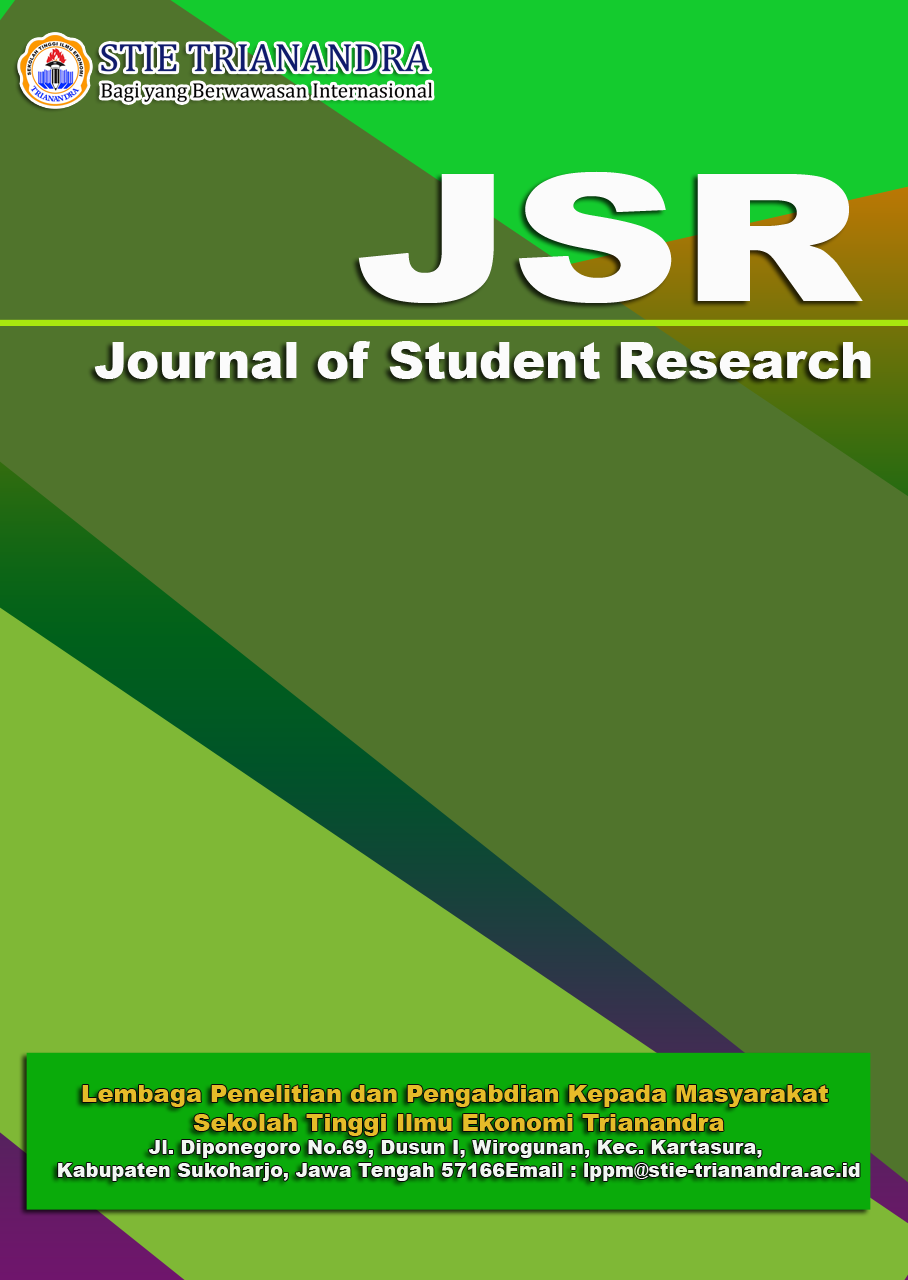PENGARUH BOPO TERHADAP ROE PADA PT. BANK NEGARA INDONESIA,TBK
DOI:
https://doi.org/10.55606/jsr.v2i3.2978Keywords:
Operational Costs on Operational Income, Return On EquityAbstract
This research aims to determine and analyze the significant influence of BOPO on ROE at PT. Bank Negara Indonesia, Tbk. This research is associative type using secondary data. The research instrument used is a list of tables containing data on operational expenses, operating income, net profit and total equity at PT. Bank Negara Indonesia, Tbk for 10 years, namely from 2013 to 2022. The population in this research is all financial reports of PT. Bank Negara Indonesia, Tbk has been listed on the IDX from 1996 to 2022, which is 26 years. The sample in this research is the financial report of PT. Bank Negara Indonesia, Tbk for 10 years, namely from 2013 to 2022. The sampling technique used in this research was purposive sampling. Data collection techniques use documentation and literature study. The data analysis technique in this research is to use component analysis of the ratio of BOPO (X) to ROE (Y) and statistical analysis consisting of simple linear regression analysis, simple correlation coefficient, determination test and t test. The research results show that there is a significant influence of Operational Costs on Operational Income (BOPO) on Return On Equity (ROE) at PT. Bank Negara Indonesia, Tbk with a strong level of relationship.
References
Haeril, H., & Albar, A. (2021). Analisis Pengaruh Risiko, CAR, BOPO dan LDR Terhadap ROE pada Perusahaan Perbankan yang Terdaftar di Bursa Efek di Indonesia. Economics and Digital Business Review, 2(1), 36–60.
Kasmir. (2019). Analisis Laporan Keuangan. Edisi Revisi. Jakarta. PT. Raja Grafindo Persada.
Khoirunnisa, H. M., Rodhiyah, & Suryadi. (2019). Pengaruh Capital Adequacy Ratio (CAR), Loan to Deposit Ratio (LDR) Dan BOPO Terhadap Profitabiliitas (ROA Dan ROE). Jurnal Ilmu Administrasi Bisnis, 5(2), 1–8.
Kurniawan, M. (2019). Pengaruh Npl, Ldr, Dan Bopo, Terhadap Profitabilitas Bank Umum. Jurnal Manajemen, 2(1), 1–13.
Maroni, M., & Simamora, S. C. (2020). Pengaruh Npl, Ldr Dan Bopo Terhadap Roe Pada Pt.Bank Mandiri (Persero) Tbk Periode Tahun 2011-2019. Jurnal Ilmiah Mahasiswa Manajemen Unsurya, 1(1), 67–82.
Nugraha, A. W., Tandika, D., & Nurdin. (2019). Pengaruh Non Performing Loan ( NPL ) dan BOPO terhadap Return On ( Studi Kasus pada PT . Bank Nusantara Parahyangan Tbk . dan PT . Bank OCBC NISP). Jurnal Prosidang Manajemen, 3(1), 141–145.
Prasetiono, & Aulia, F. (2019). Pengaruh CAR , FDR , NPF , Dan BOPO Terhadap Profitabilitas (Studi Empiris pada Bank Umum Syariah di Indonesia Periode Tahun 2009-2013 ). Diponegoro Journal of Management, 5(1), 1–10.
Puspitasari, C., Aprilia, F., Mentarie, M., & Bilkis, M. S. (2021). Pengaruh NIM, LDR, dan BOPO terhadap Profitabilitas Perbankan yang Tercatat di BEI Selama Pandemi. Global Financial Accounting Journal, 5(1), 47.
Ramadhani, I., & Ekawaty, M. (2019). Analisis Pengaruh FDR, CAR, NPF, dan BOPO terhadap Profitabilitas Bank Syariah di Indonesia (Studi Kasus Bank Syariah Mandiri Periode 2008-2017). Jurnal Ilmiah, 1(1), 1–13.
Rohimah, E. (2021). Analisis Pengaruh BOPO, CAR, dan NPL Terhadap ROA Pada Bank BUMN Tahun 2012-2019 (Studi pada Bank BUMN yang Go Public di Bursa Efek Indonesia). Jurnal Ilmiah Mahasiswa Akuntansi (JIMA), 1(2), 133–145.
Sugiyono. (2019). Metode Penelitian Kuantitatif Kualitatif dan R&D. In Bandung: Alfabeta.
Sujarweni, V. W. (2019). Analisis Laporan Keuangan : Teori, Aplikasi, & Hasil Penelitian. Pustaka Baru Press.
Tricahyanti, S., & Muniarty, P. (2022). Analisa Pengaruh BOPO terhadap ROE pada PT. Bank Negara Indonesia (BNI), Tbk. Target: Jurnal Manajemen Dan Bisnis, 4(2), 229–236.









